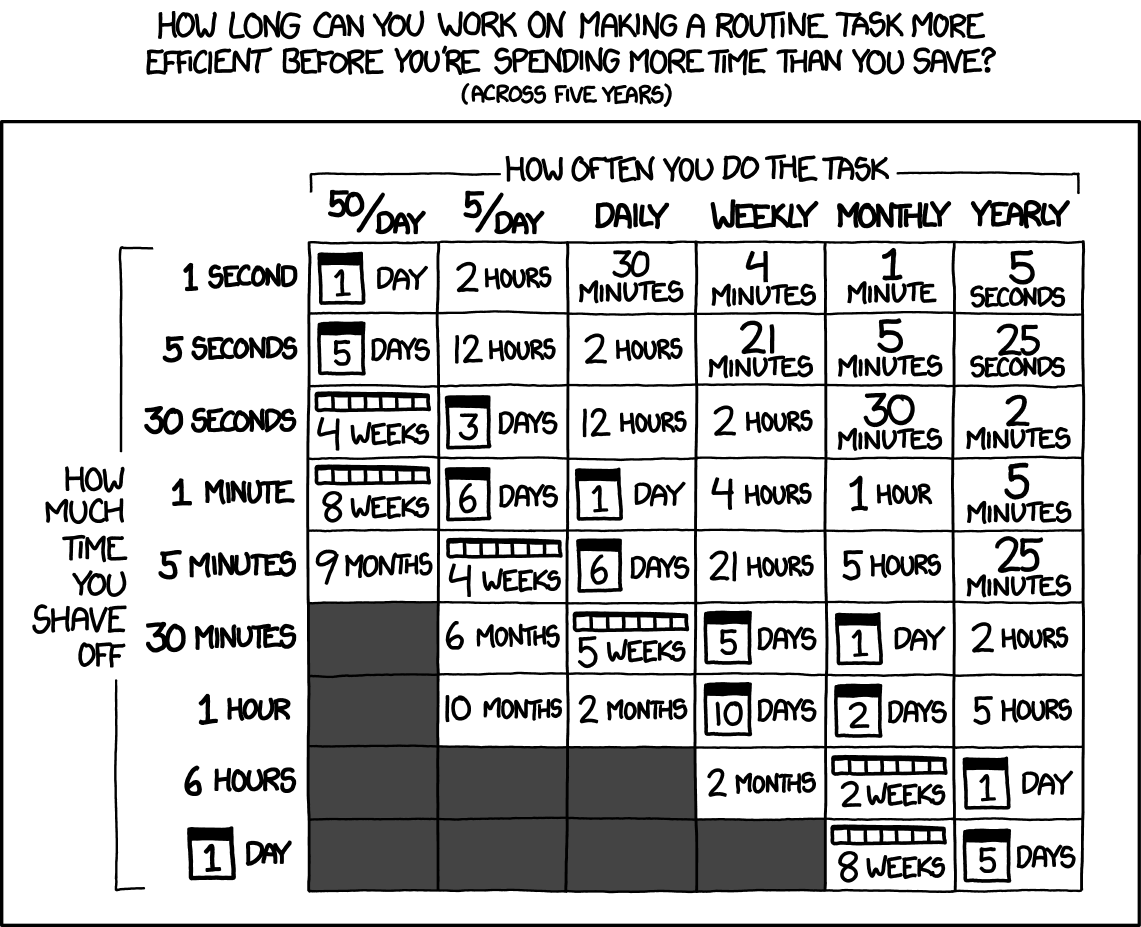

So they can blow it on functions they cancel :)


So they can blow it on functions they cancel :)


Ensure you aren’t a bot I guess, and if somebody programs the paste text they can switch the text to copy from?


Then they went back to Linux a few years pater


No, but it will mean apps get written for Linux, due to market share


They then switched back to Linux
Getting an egg in a Pizza Pocket has its own challenges
Even tacos are stupidly priced. I found a local Indian grocery store selling 90 packs of raw corn tortillas (frozen). You just pan fry with a bit of oil and bend them while cooling. Works out to 10 cents a shell. Plus filling.
This site has good benchmarking of unoptimized and optimized code for several languages. C+ blows Python away. https://benchmarksgame-team.pages.debian.net/benchmarksgame/index.html
Agreed. Or look at the manual effort, is it worth coding it, or just do it manually for one offs. A coworker would code a bunch of mundane tasks for single problems, where I would check if it actually will save time or I just manually manipulate the data myself.
Maybe, I’m biased on all my friends from highschool onward. We lost touch because of moves and family obligations…but when we find each other again is is like no time has past.
If that’s the case, my gut feeling is you may have been friends out of convenience. For friends I haven’t talked to in decades; we pick up like no time has passed at all.
Because when it is to actually get paid work done, all the bloat adds up and that 3 days upfront could shave weeks/months of your yearly tasks. XKCD has a topic abut how much time you can spend on a problem before effort outweighs productivity gains. If the tasks are daily or hourly you can actually spend a lot of time automating for payback

And note this is one instance of task, imagine a team of people all using your code to do the task, and you get a quicker ROI or you can multiply dev time by people
Decades ago I would prebuy their burittos in evening and throw them in fridge at home, and then take them for breakfast the next day. But their prices have jumped so much, and the quality dropped so much that I now make everything from scratch at home and it is much more satisfying
That stuff will kill you or maybe preserve you. A guy I know worked there as a manager and later moved to an internal corp Starbucks role. He said never buy any of their food. It is loaded with junk so the shelf life is super super long.


I was watching a Netflix documtary about killers, the guy said he was on drugs by age 9…so pretty sure that messed up his life before the murder. It is debatable on if surroundings or self choices are why you try drugs I guess.


Ours was exactly that, the oulet and inlet pipes in the tank corroded badly. Cold pressure fine, hot pressure was flow restricted


I grew up in Britain no one I knew says sinjin, but Sinclair,warrik (Warwick) etc were the norm
A few for different use cases. NixOS on my wife’s 14 year old laptop because it proved to handle the hardware the best, and she struggles with change so if that system dies the NixOS configuration can be redeployed identical to how she had it with no additional effort.
Debian on my old IOmega NAS.
OpenSUSE on my personal PC and Work computer, since it supports my proprietary CAD software, and nVidia releases a driver specifically for SUSE/OpenSUSE use.
Steam for your PC will have a large library of free games you can try, and also paid games. If you like board or card games there is an application called table top simulator. This opens up access to traditional board games people have converted to PC–when you can’t find it as a standalone game. Also a suggestion for standalone games if you are into cards:
Wingspan. It has a steep learning curve but hours of fun once you learn it.
Dominion. If you like this genre of game it can be a lot of fun.
Catan. if you have played Catan board game and enjoy it, you can also play online for free https://catanuniverse.com/en/game/
So Technically No. Our proprietary CAD was only supported and certified to work on RHEL or SUSE. I wanted to test before commiting to a distro. So I went with OpenSUSE leap since it shares SUSE binaries and has same release and service cycle. It installed and functions well on OoenSUSE While not identical to SUSE, I can say all the complaints I saw online of things not working in Linux were working for me. They sort of have to on a paid distro with support, so it seems to carry to OpenSUSE with the same binaries
2)btrfs works. I saw lots of complaints of people saying btrfs filled their drive, etc. SUSE / OpenSUSE as jobs establishes to monitor number and age of snapshots and remove automatically as needed as well as cleaning tools. It all runs behind the scenes.
I assume RHEL will also have these types of perks to make some aspects easier